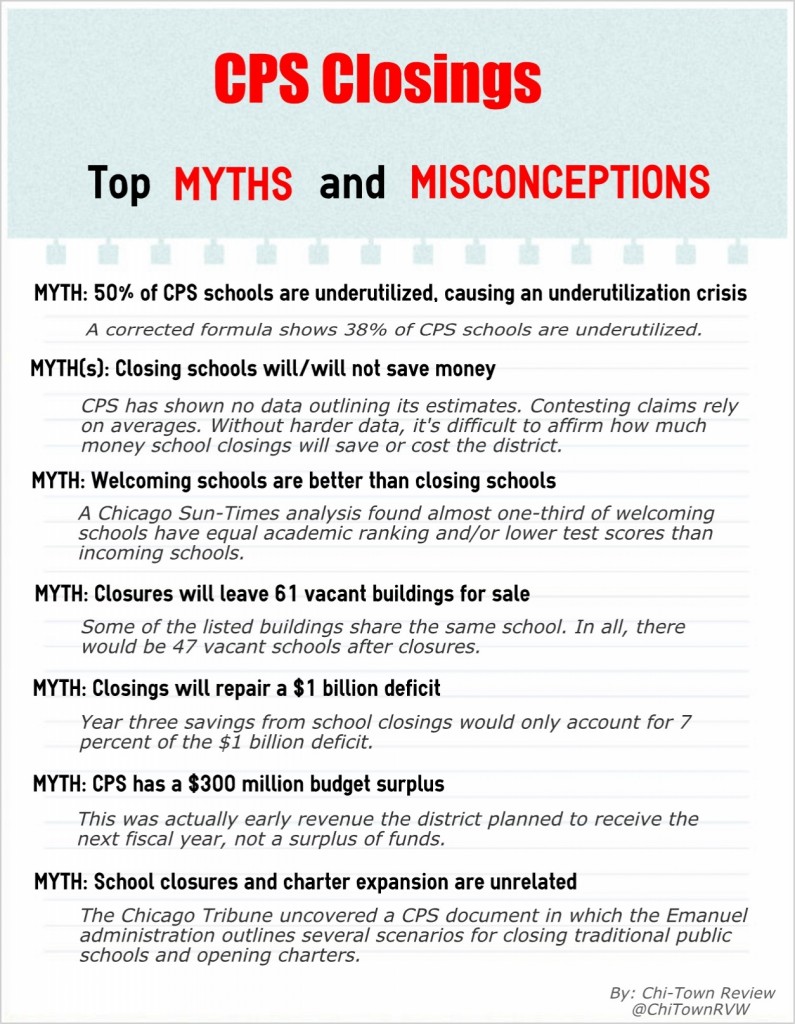
As both sides of the school closings debate square off, facts and figures get tossed, spun and scrambled. Chi-Town Review is setting the record straight on some of the myths and misconceptions that have spawned from the debate.
MYTH: 50% of CPS schools are underutilized, causing an underutilization crisis
FACT: Raise Your Hand for Illinois Public Education found a discrepancy in the formula Chicago Pubic Schools uses to determine underutilization and overcrowding in elementary schools. The formula uses 30 as an ideal class size, but using this number returns 36 as the maximum class size before CPS considers a room overcrowded. This number contradicts CPS’s own policy for maximum class sizes–which average out to 29. Raise Your Hand adjusted the formula using 30 as the maximum class size and found that, according to the new formula, 38 percent of schools–not 50 percent–are underutilized, and 31 percent of elementary schools–not 14 percent–are overcrowded.
MYTH(s): Closing schools will/will not save money
FACT: CPS officials say initial investments in welcoming schools will total $233 million, and that the closures will save almost $100 million annually. This would produce savings by year three. But as of April 1, CPS has shown no data or outlines supporting the estimates, which the Chicago Teachers Union contends should be several times higher.
The CTU says school closings will actually cost CPS $1 billion. But because CPS hasn’t released details of its costs estimates, union officials calculated the average costs of various school improvements for their analysis. The union’s estimate also combines the costs of providing welcoming schools promised supports, with standard improvements the schools may have received despite the closings.
Without harder data, it’s difficult to say how much money school closings will save the district, or when.
MYTH: Welcoming schools are “better” than closing schools
FACT: A Chicago Sun-Times analysis found almost one-third of welcoming schools have equal academic ranking than the closing schools coming in. Some of those schools are on probation. A few welcoming schools also have lower standardized test scores. According to district leaders, however, schools’ test scores and academic levels are not sole factors in determining “higher performance.”
MYTH: Closures will leave 61 vacant buildings for sale
FACT: While CPS reports school closings would create 61 vacant school buildings, some of these buildings belong to the same school. In all there would be 47 different schools left vacant after the closures.
MYTH: Closings would repair a $1 billion deficit
FACT: CPS is currently facing a $665 million deficit. The district is expecting a $1 billion deficit as early as the next fiscal year and over three years. But year three savings from school closings would only account for 7 percent of the $1 billion deficit.
MYTH: CPS actually has a $300 million budget surplus
FACT: The Chicago Teachers Union claimed to have found a surplus in CPS’ budget for fiscal year 2012. This turned out to be early revenue the district budgeted for the next fiscal year, not a surplus of funds.
MYTH: School closures and charter expansion are unrelated
FACT: The closing of traditional schools and the opening of charters are closely related. Language in the CPS fiscal year 2013 budget suggests the district’s goal to increase access to high-performing schools includes closing low performing traditional schools and expanding charters. Mayor Rahm Eamanuel’s plan to expand Chicago charters is also well documented. Last December Chicago Tribune uncovered a CPS document in which the Emanuel administration outlines several scenarios for closing traditional public schools and opening charters.
And there you have it: top myths and misconception in the #CPSClosings debate, debunked. What do you think? Sound off in the comments, the forums or on Twitter @ChiTownRVW
